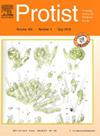Slowly evolving proteins support the monophyly of Craspedida (Choanoflagellatea) and a marine origin of choanoflagellates
IF 2.1
3区 生物学
Q4 MICROBIOLOGY
引用次数: 0
Abstract
Choanoflagellate species have been taxonomically divided upon the morphological and developmental basis of their extracellular coat (periplast). Species within the order Craspedida possess a purely organic periplast, whereas taxa of the order Acanthoecida have an additional silica based periplast termed the lorica. Whilst small-scale phylogenetic studies have recovered the two orders as monophyletic, recent phylogenomic analyses have rejected the monophyly of the craspedids. These analyses suggest that the freshwater craspedid Codosiga hollandica falls within the earliest branching choanoflagellate lineage; however, it has also been noted that phylogenomic studies result in inconsistent phylogenies, with unstable long-branched species being recovered as basal choanoflagellates. Presented here are phylogenetic analyses, based upon slowly evolving ribosomal proteins, which consistently recover both craspedid monophyly and a derived placement of C. hollandica. The addition of further, long-branched, ribosomal proteins to phylogenetic analyses are shown to generate longer terminal branches and a weakening of the support for Craspedida. The analyses highlight the requirement for an increase in data, in terms of both taxa and gene coverage, to successfully resolve the earliest craspedid branches. In addition, phylogenetically unstable species are identified that are recommended to be omitted from phylogenomic studies as they have the potential to disrupt recovered relationships.
缓慢进化的蛋白质支持石门(长鞭毛虫)的单一性和长鞭毛虫的海洋起源。
根据细胞外被毛(周质)的形态和发育基础,鞭毛类植物已被分类。石门目的种具有纯粹的有机外质体,而棘皮目的分类群具有额外的二氧化硅基外质体,称为lorica。虽然小规模的系统发育研究已经恢复了这两个目的单系性,但最近的系统发育分析已经拒绝了石门的单系性。这些分析表明,淡水石竹属荷兰石竹属最早的支尾鞭毛虫谱系;然而,也有人指出,系统发育学研究结果不一致,不稳定的长分支物种被恢复为基础鞭虫。这里提出了系统发育分析,基于缓慢进化的核糖体蛋白,一致地恢复了石杉的单系和荷兰石杉的衍生位置。在系统发育分析中添加更多的长分支核糖体蛋白会产生更长的末端分支,并削弱对蜈蚣的支持。这些分析强调了在分类群和基因覆盖范围方面增加数据的需求,以成功地解决最早的蔓足类分支。此外,系统发育不稳定的物种被确定,建议从系统发育研究中省略,因为它们有可能破坏恢复的关系。
本文章由计算机程序翻译,如有差异,请以英文原文为准。
求助全文
约1分钟内获得全文
求助全文
来源期刊

Protist
生物-微生物学
CiteScore
3.60
自引率
4.00%
发文量
43
审稿时长
18.7 weeks
期刊介绍:
Protist is the international forum for reporting substantial and novel findings in any area of research on protists. The criteria for acceptance of manuscripts are scientific excellence, significance, and interest for a broad readership. Suitable subject areas include: molecular, cell and developmental biology, biochemistry, systematics and phylogeny, and ecology of protists. Both autotrophic and heterotrophic protists as well as parasites are covered. The journal publishes original papers, short historical perspectives and includes a news and views section.
 求助内容:
求助内容: 应助结果提醒方式:
应助结果提醒方式:


